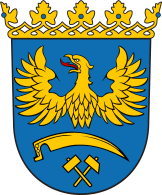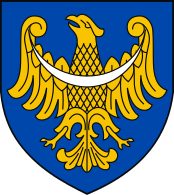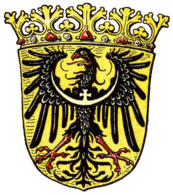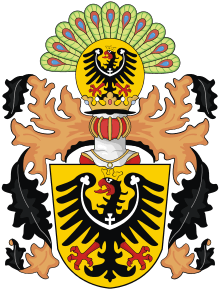Coat of arms of Silesia
The coat of arms of Silesia is derived from the ancestral arms of the Silesian Piasts. The image of the eagle was used by the Opole prince Kazimierz I in 1222. It is also the oldest image of the eagle as the prince's emblem on the Polish lands.

In Lower Silesia, a black eagle on a golden field (with a silver band on its wings) was used, often with a white cross in the middle (of Henry the Bearded), while the lands of Upper Silesia usually used a golden eagle on a blue field.[1]
Upper and Lower Silesia
Lower Silesia uses silver (from the strip on the eagle's chest, the emblem of Prince Henry the Bearded) and gold. It has been assumed in the tradition that the coat of arms and colors of Lower Silesia are simultaneously used as symbols of Silesia as a whole.
In the Prussian province of Upper Silesia (1919–1945), the shield was partitioned in the middle by a scythe blade, below which the miner's emblem was located.[2] In the Polish tradition, the Silesian eagle is not crowned (with the exception of Cieszyn Silesia), whereas in the Czech (see the coat of arms of the Czech Republic and the arms of Austrian Silesia) and German traditions it is generally the opposite, although the eagle in the coat of arms of Prussian Upper Silesia did not have a crown.
The colors of the lands are related to the colors of their coat of arms. Upper Silesia uses gold and blue respectively. In Prussian times, Lower Silesia used a flag with two stripes (horizontal) of equal width, silver at the top and gold at the bottom, while Upper Silesia had a flag with a yellow stripe at the top and blue at the bottom.
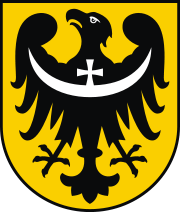 Coat of arms of Lower Silesia
Coat of arms of Lower Silesia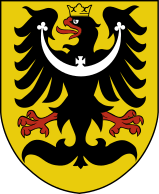 Coat of arms of Czech Silesia
Coat of arms of Czech Silesia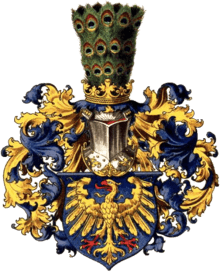 Coat of arms of Upper Silesia, by Ströhl
Coat of arms of Upper Silesia, by Ströhl
History
Upper Silesia
The Upper Silesian Piasts had an emblem in two variants: with or without a crown. The crown was added later, with only the Dukes of Opole and then Teschen having the crowned eagle in their coat of arms.
The golden eagle in the blue field was inherited by the dukes of such Silesian principalities as: Opole, Niemodlin, Strzelce, Kozielsko-Bytom, Bytom, Racibórz, Teschen, Prudnica, and before the purchase by the Polish king also the ruler of the Oświęcim.
The oldest color image of the coat of arms of Opole has been preserved at the castle in Lauf near Nuremberg, where in 1353 114 coats of arms of princes, bishoprics and cities were carved in stone.
Lower Silesia
For the first time, the coat of arms was used by Henry II the Pious in 1224–1240. This coat of arms was also featured on seals of subsequent dukes of Lower Silesia: Henryk III, Henryk IV, Bolesław II Rogatka, Henryk V, Bolesław III, Konrad I, Henryk III of Głogów, Bolko I, Bernard, Henryk I, Bolko II.
The coat of arms was used in the 2nd half of the 14th century, however, some did not add the cross to the band. It took place in the Duchies of Oleśnica and Brzeg. As Silesia was more divided, other eagle colors were also adopted. In the Duchy of Świdnica, in the silver field there was a half-red black and red eagle with a headband, and in the Duchy of Münsterberg there was a red and black eagle.[3]
Modern use
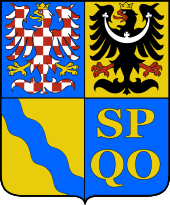
Currently, the traditional coat of arms of the Lower Silesian Piasts (black eagle) can be observed on the coats of arms of:
The eagle of the Upper Silesian Piasts is in the coat of arms of Silesian Voivodeship and the coat of arms of Opole Voivodeship.[6][7]
In the coat of arms of Bohemia, there is a black eagle, symbolizing Silesia. In the interwar years, the coat of arms was adopted to the coat of arms of Czechoslovakia.
References
- Znamierowski, Alfred, 1940- (2003). Insygnia, symbole i herby polskie : kompendium. Warszawa: Świat Książki. ISBN 83-7311-601-X. OCLC 56584943.CS1 maint: multiple names: authors list (link)
- "Österreichisch Schlesien". deutsche-schutzgebiete.de (in German). 2017-07-07. Retrieved 2020-02-12.
- Znamierowski, Alfred, 1940- (2003). Insygnia, symbole i herby polskie : kompendium. Warszawa: Świat Książki. ISBN 83-7311-601-X. OCLC 56584943.CS1 maint: multiple names: authors list (link)
- "Česká a československá vlajka". 2005-03-08. Archived from the original on 2005-03-08. Retrieved 2020-02-12.
- "Suche - Konsolidiertes Recht | Lilex - Gesetzesdatenbank des Fürstentum Liechtenstein". www.gesetze.li. Retrieved 2020-02-12.
- "Polskie herby i flagi – Instytut Heraldyczno-Weksylogiczny" (in Polish). Retrieved 2020-02-12.
- "Uzasadnienie historyczno-heraldyczne do projektów herbu, flagi i pieczęci Województwa Śląskiego - Województwo Śląskie". www.slaskie.pl. Retrieved 2020-02-12.
Literature
- Maximilian Gritzner: Landes- und Wappenkunde der Brandenburgisch-Preußischen Monarchie. Geschichte ihrer einzelnen Landestheile, deren Herrscher und Wappen. Heymann, Berlin 1894.

